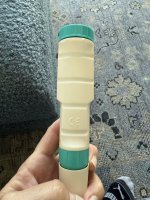- Oct 26, 2014
- 206
- Pool Size
- 18000
- Surface
- Plaster
- Chlorine
- Salt Water Generator
- SWG Type
- Pentair Intellichlor IC-60
Bought an electric pH test meter. It didn't come with any instructions for calibration. It did come with 3 packets of powder that gets mixed for the low, med and high pH tests for the calibration however. It did NOT come with any instructions about how to use and how to store. It did say it comes calibrated and only needs recalibration about once a year. So I mistakenly thought that I just dip the sucker in the pool and read it. However the meter changes and never stops. It will start at 7.6 and then keeps rising and stops finally around 8.74 or something. This goes on for close to a minute or more. However using the drop test with my Taylor test kit reads 7.6 if I am reading the colors correctly. So I must be doing something wrong with the electric meter. I am solid on using the Taylor and I trust it above all else.
I read about storing the pH meter in a solution, what solution? My meter comes with a cap. I always rinse it in R/O water after testing the pool water, and then pop the cap on and put it in a drawer. I don't trust the thing. I've been reading that the pH meters need to calibrated every week. What!? That sounds like an awful lot of work, and for what. The whole purpose of buying the thing was to save time and money buying drops. It takes less than 30 seconds to use the Taylor test. If I need to buy calibration solutions all the time- what good is the meter? Not only does it cost a pretty penny, constantly having to buy calibration solutions doesn't sound cheap either.
So I am wondering about other peoples experiences using an electric pH meter. My whole purpose with buying one in the first place was so I could be more accurate in my testing. However, since I can't trust it, the accuracy isn't happening. No I haven't calibrated it yet and yes it reads 7.0 when testing the R/O water.
I read about storing the pH meter in a solution, what solution? My meter comes with a cap. I always rinse it in R/O water after testing the pool water, and then pop the cap on and put it in a drawer. I don't trust the thing. I've been reading that the pH meters need to calibrated every week. What!? That sounds like an awful lot of work, and for what. The whole purpose of buying the thing was to save time and money buying drops. It takes less than 30 seconds to use the Taylor test. If I need to buy calibration solutions all the time- what good is the meter? Not only does it cost a pretty penny, constantly having to buy calibration solutions doesn't sound cheap either.
So I am wondering about other peoples experiences using an electric pH meter. My whole purpose with buying one in the first place was so I could be more accurate in my testing. However, since I can't trust it, the accuracy isn't happening. No I haven't calibrated it yet and yes it reads 7.0 when testing the R/O water.




